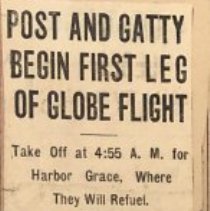Archive Record
Images

Metadata
Catalog Number |
2019.001.066 |
Object Name |
Clipping, Newspaper |
Title |
Post and Gatty Begin First Leg of Globe Flight |
Collection |
Wiley Post Collection |
Creator |
Unknown |
Scope & Content |
A continued fraction of an article discussing Harold Gatty and Wiley Post's flight progress from Berlin to Moscow. |
Date |
06/25/1931 |
Year Range from |
1931 |
Year Range to |
1931 |
Transcription |
[Top] Post and Gatty Begin First Leg Of Globe Flight ——— Take Off at 4 :55 A.M. for Harbor Grace, Where They Will Refuel. ——— Plan Hop To Berlin Today ——— New Ground-Speed Indicator Expected to Aid Fliers in Navigation. ——— (Continued from Page One) running off our course," said Gatty, who is considered one of the best aerial navigators in the world and who last year guided Harold Bromley safely back to Tokio when he lost his way at the start of their flight to America. White and Post were discussing plans for refueling on the flight about 4:40 when a man interrupted them. "How soon are you going, Wiley?" "Fifteen minutes." The Flashlight Salute. A moment later, Post climbed into the cabin. "Somebody want to crank me up?" he asked. The propeller spun. The motor thundered. Gatty walked around the plane wiping off windows. He climbed in. "All right, Wiley!" "Okay. We’re on our way." The plane taxied down the field, turned and roared back past the little crowd of watchers as flash- light powder boomed. At 4:55, it was off the ground. I soared up, the blue lettering of the name and the license number—NR-105-W—bright in the light of flares. Then it was gone. Russia, Siberia, Alaska, Home. From Berlin the fliers plan to hop 994 miles to Moscow, the shortest jump. Thence they are to fly 2,604 miles to Irkutsk on to Yakutak or Khabarovsk, depending on local landing conditions and the availability of fuel, and 2,441 miiles [sic] across Siberia and Bering Straits to Nome, Alaska. Their course then leads to Edmonton, Alberta, to Cleveland and then back to Roosevelt Field. The present round-the-world record, twenty-two days, is held by the Graf Zeppelin. Although these fliers carry neither parachutes nor a rubber boat, the Post-Gatty expedition gives the Impression of being the most thoroughly prepared and well-rounded of all those in the 1931 transatlantic lists. Post is rated as one of the best pilots in America, and Gatty one of the world’s best aerial navigators. There is much optimism among fliers concerning their chances of success. Included in their excellent equipment is an ingenious device invented by Gatty for telling the so-called "ground speed" of an airplane in flight—its actual progress, regardless of wind direction or force. Unlike similar indicators, it can be used over unbroken sea or even on top of fog and cloud banks. Speed Gauge "Eye." The operator looks down at the land or sea through a transparent film which moves at a constant and known speed, and adjusts the distance of an eyepiece above the film until both it and the earth’s surface appear to be moving at the same speed. The altitude of the plane, the distance of the eyepiece from the film and the known speed of the moving film thus furnish an equation which gives the actual rate at which the plane is travelling toward its objective. The same device is used to determine the side drift of the plane. Only one accident marred the take-off today. As the Winnie Mae left the ground a premature explosion of flashlight powder burned Herbert McCory, a Daily News photographer, on the arm and hand. He was treated in the first aid station at the field. |
People |
Harold Gatty Wiley Post |
Search Terms |
Article Aviation Flight Russia Siberia World |
